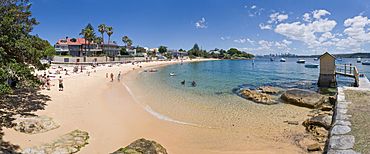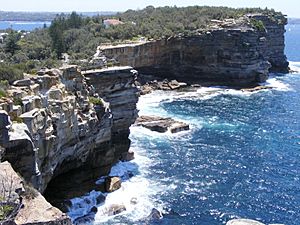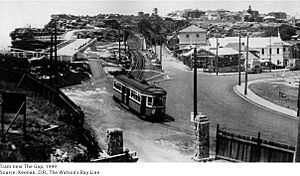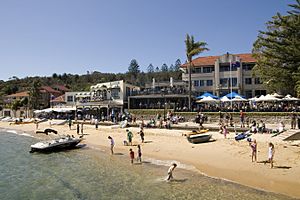Watsons Bay facts for kids
Quick facts for kids Watsons BaySydney, New South Wales |
|||||||||||||||
|---|---|---|---|---|---|---|---|---|---|---|---|---|---|---|---|

Camp Cove beach in Watsons Bay
|
|||||||||||||||
| Established | 1801 | ||||||||||||||
| Postcode(s) | 2030 | ||||||||||||||
| Elevation | 6 m (20 ft) | ||||||||||||||
| Area | 0.6 km2 (0.2 sq mi) | ||||||||||||||
| Location | 11 km (7 mi) north-east of Sydney CBD | ||||||||||||||
| LGA(s) | Municipality of Woollahra | ||||||||||||||
| State electorate(s) | Vaucluse | ||||||||||||||
| Federal Division(s) | Wentworth | ||||||||||||||
|
|||||||||||||||

Watsons Bay is a beautiful suburb right on the harbour in Sydney, Australia. It's located about 11 kilometres north-east of the main city area, known as the Sydney central business district. This lovely spot is part of the Municipality of Woollahra.
Watsons Bay sits at the very end of the South Head peninsula. It got its name from the calm bay on its western side, which is part of Port Jackson (Sydney Harbour). From here, you can see amazing views across the harbour, including the famous Sydney Harbour Bridge. On the eastern side, you'll find The Gap, a dramatic ocean cliff with stunning views of the Pacific Ocean and Manly at North Head. The only suburb next to Watsons Bay is Vaucluse, to the south.
Contents
History of Watsons Bay
First People of Watsons Bay
The first people to live in the area we now call Watsons Bay were the Cadigal people. They called this place Kutti. These clever people fished and gathered shellfish from the waters and bays around South Head. They found food at Camp Cove and even carved pictures into the rocks there. Over time, these rock carvings have worn away.
European Settlers Arrive
The first Europeans came to Watsons Bay on January 21, 1788. This was the First Fleet, and they spent a night at Camp Cove. A lookout was built on the cliffs in 1790 to watch for ships. The first piece of land, about 20 acres, was given to Edward Laing in 1793 near Camp Cove. Early homes were built for government and military workers.
Watsons Bay was named after Robert Watson (1756–1819). He used to be on a ship called HMS Sirius. He became the harbour pilot and harbourmaster of Sydney in 1811. He was also the first person in charge of the Macquarie Lighthouse in 1816.
For a long time, Watsons Bay was a quiet fishing village. But in the 1860s, it started to grow. The number of people living there increased from about 36 in 1828 to 122 in 1841. Land began to be divided up and sold in the 1850s. When a ferry service started in the 1870s, several hotels opened, making it a more popular spot.
The Dunbar Shipwreck
The ship Dunbar was wrecked near the entrance to Sydney Harbour in 1857. It was a terrible disaster, and 121 people lost their lives. The Dunbar crew mistook The Gap bay for the harbour entrance in a storm. This sad event led to the building of the Hornby Lighthouse to help guide ships safely. Years later, in 1910, the ship's anchor and other items were found. The anchor is now part of a memorial at Gap Park.
Trams in Watsons Bay
Trams used to be a big part of getting around Sydney! The tram line from the city was extended to Watsons Bay in 1903, and then further to Gap Park in 1909. This extension included a special tram stop right next to The Gap. There was even a tram cutting carved into the rock face at Gap Park.
The tram line started in the city and wound its way through different streets, including King Street and William Street. It passed through areas like King's Cross and Rushcutters Bay before following New South Head Road and Old South Head Road to Watsons Bay. The line had its own depot and operated mostly on its own, though it was connected to the main Sydney tram network.
In 1949, the tram line to Watsons Bay closed for a short time. But people protested, so it reopened in 1950! However, the rest of the line closed in 1960. The tracks were removed, and the area where the tram cutting was in Gap Park was replanted with trees and plants.
Today, if you walk up the steps to The Gap, you might notice a flat area between two sets of steps. This is actually where the old tram line used to run! The current Transdev John Holland bus route 324 follows much of the old tram route.
Sydney Harbour Defences in World War II
During World War II in 1942, a special net was built across Sydney Harbour. This was called the Sydney Harbour anti-submarine boom net. Its job was to stop enemy submarines from getting into the harbour. Part of this net system, a winch house, was located at Liangs Point in Watsons Bay.
On the night of May 31, 1942, three Japanese midget submarines tried to sneak into Sydney Harbour. This event is known as the attack on Sydney Harbour. One of the submarines got caught in the boom net. After trying to get free, the crew blew up their submarine, destroying it and themselves.
During this time, Nielsen Park was used as a base to protect against enemy aircraft. It had barracks (places for soldiers to sleep), searchlights, and anti-aircraft guns. In Gap Park, there was also a place for a small gun, though it was never installed.
Christina Stead's Home
The famous writer Christina Stead lived in a house at 14 Pacific Street from 1911 to 1928. A special plaque on the footpath marks her former home. This house, called Boongarre, was built in the 1870s. It was owned by Christina Stead's family for many years. The house is now considered a heritage site by the local council.
Population of Watsons Bay
In the 2021 census, there were 883 people living in Watsons Bay. Most people (64.6%) were born in Australia, and 78.0% spoke only English at home. When asked about their religion, the most common answers were No Religion (33.8%) and Catholic (19.2%).
Landmarks and Fun Things to Do
Watsons Bay is mostly a place where people live, but it also has some great spots for fun and relaxation. You can visit beautiful beaches like Camp Cove. There are also restaurants, cafes, and a hotel. The coastal walk along The Gap, with its amazing ocean views, makes Watsons Bay a very popular tourist attraction in Sydney. The Sydney Harbour Pilot Boat Station used to be here, and the naval training base HMAS Watson is nearby at South Head.
Heritage Buildings
Watsons Bay has many important historical sites and buildings. Some of these include:
- The ship Dunbar (the shipwreck site).
- Hornby Lighthouse on Old South Head Road.
Many buildings are also listed as heritage items by the local council. These include:
- Buildings 28–31 at HMAS Watson.
- Hornby Lighthouse and its two cottages.
- St Peter's Church on Old South Head Road, built in 1864.
- Our Lady Star of the Sea Church on Old South Head Road, built between 1909 and 1910.
- The Scout hall at 335 Old South Head Road, which used to be a school built in 1876.
- A former school residence on Old South Head Road, also built in 1876.
- The former marine station at Pacific Street and Laings Point, built in 1885.
- A sandstone monument in Robertson Park, celebrating the building of Old South Head Road in 1811.
- Boongarre, Christina Stead's former home on Pacific Street.
Fun Events
Every Man and His Dog is a super fun event held every year in Watsons Bay on Australia Day (January 26). In this event, people and their dogs team up on the same stand-up paddle board and race against other dog lovers. Many people even dress up in matching costumes with their dogs!
Other Cool Places to Visit
- Bottle and Glass Point
- Doyles on the Beach (a famous seafood restaurant)
- Hermitage Foreshore Track (a walking path)
- Macquarie Lighthouse
- Milk Beach Vaucluse
- Nielson Park
- The Federation Cliff Walk
- Shakespeares Point
- Vaucluse House
Famous People from Watsons Bay
Some well-known people who have lived in Watsons Bay include:
- Herbert Badham (1899–1961), a famous Australian painter.









